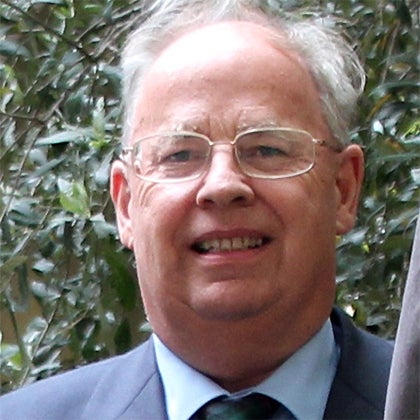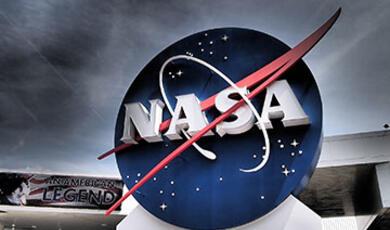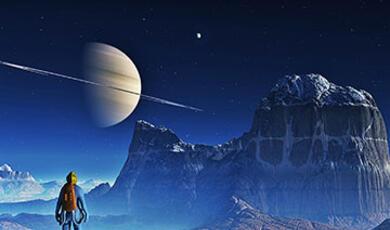Harbingers of Doom?
Share
- Details
- Transcript
- Audio
- Downloads
- Extra Reading
Though a beautiful sight in our heavens, comets were once thought to be evil vapours burning up in our atmosphere. However, we now know that they have brought organic material and water to our planet Earth so helping to lay the foundations of life. But, equally, one could bring about the end of civilisation!
Download Transcript
HARBINGERS OF DOOM?
Professor Ian Morison
Harbingers of Doom
The comet Hale-Bopp seen close in the sky to the Andromeda Galaxy.
Aristotle proposed the idea that comets were a gaseous phenomena in the upper atmosphere that occasionally burst into flames. He depicted comets as 'stars with hair' and used the Greek word 'kometes' to refer to them from the root 'kome' meaning 'head of hair'. They were regarded as bad omens foretelling catastrophe or the deaths of kings. (Comet Halley is seen in the Bayeaux Tapestry in the sky above King Harold, who was killed by an arrow in 1066!)
Tycho Brahe made careful observations of the comet of 1577 and, by measuring its position from well separated locations, was able to show that it lay at least four times further away than the Moon. In 1687, Isaac Newton was able to show that the path of a bright comet observed through the winter of 1680/1681 could be fitted to a parabolic orbit with the Sun at one focus. He had thus shown that comets were Solar System bodies orbiting the Sun.
3.7.1 Halley's Comet
Giotto de Bondone's "Adoration of the Magi". Giotto had seen Halley's Comet in 1301
and depicted it as the "Star of Bethleham" in his fresco painted in 1305.
Edmund Halley calculated the orbits of twenty-four comets that had been observed between 1337 and 1698. He found that the comets that had been seen in 1531, 1607 and 1682 had very similar orbital elements and so believed that these were three 'apparitions' of the same comet. Halley could even account for the slight differences by taking into account the gravitational effects of Jupiter and Saturn. Its period was ~76 years so he predicted that it would return around the end of 1757. More accurate calculations by three French mathematicians indicated that it would, in fact, pass closest to the Sun in March 1759. It was first spotted by Johann Georg Palitzsch, a German farmer and amateur astronomer on Christmas day 1758. Halley, who had died in 1742, did not live to see the comet's return but it was named after him with the designation 1P/Halley - the "1P" indicating that it was the first known periodic comet.
Halley's Comet in the Bayeux Tapestry as it had appeared in the sky in 1066
- certainly a bad omen for King Harold!
Dependent on the Earth's orbital position as Halley nears the Sun, it can either appear bright and spectacular as it did in 1066 and 1910 or, as in its last apparition in 1985/86 when far from the Earth, barely visible to the unaided eye. The comet was first photographed in 1910 when it made a very close approach to the Earth - which even passed through its tail causing some alarm! It is thought that the artist Giotto di Bondone observed the comet in 1301, and used it to depict the Star of Bethlehem in his 1305 fresco, 'The Adoration of the Magi'. As a result, the spacecraft sent to fly-by Comet Halley in 1985 was called 'Giotto'. Halley's Comet will next appear in our skies in 2061.
A comet is now classified as a Small Solar System Body that orbits the Sun and which, when close to the Sun, exhibits a visible coma (an extended atmosphere) and sometimes a tail. The 'nucleus' of a comet is typically of order 10 km in size and is composed of rock and dust bound together by ice. The term 'dirty snowball' that is sometimes used is thus quite apt. Those that are termed 'long-period' comets are debris left over from the condensation of the solar nebula and come from the outermost regions of the Solar System, up to a light year distant from the Sun, in what is usually termed the Oort Cloud.
The cloud is thought to contain of order a trillion comets and is named after the Dutch Astronomer, Jan Hendrik Oort who popularised the idea in 1952. However the concept was first proposed by an Estonian Astronomer, Ernst Opik, in 1932 so it is alternatively, and more correctly, called the Opik-Oort cloud. Such comets will normally only ever been seen once, but occasionally their orbit will be sufficiently perturbed by Jupiter or Saturn to be 'captured' within the inner Solar System with a relatively short period. It will then become known as a 'short-period' comet which have, by definition, a period of less than 200 years. However, the majority of short-period comets are thought to originate in the Kuiper Belt, which lies beyond the orbit of Neptune. Of the ~3000 comets known by the end of 2007, several hundred have short periods. On average about one comet per year will reach unaided-eye visibility, but only about one in ten of these will become easily visible.
Cometary Nuclei
The nuclei of comets range from about one half to fifty kilometres in size and have a very rich composition; primarily made of rocks, dust and water ice along with frozen gases such as carbon dioxide, carbon monoxide, methane and ammonia. This 'Dirty Snowball' idea was proposed by Fred L. Whipple in 1950 who had discovered 6 comets himself. It is more formally known as the 'icy conglomerate' theory. They also contain many organic compounds such as methanol, formaldehyde, ethanol and ethane and possibly even more complex molecules such as amino acids. They are far too small to become spherical through the force of gravity and are thus irregularly shaped.
Due to their small size and low albedo, comets cannot normally be seen in the outer Solar System. As a comet approaches the inner solar system, solar radiation causes water, frozen gases and other volatile materials within the comet to vaporize and stream out of the nucleus. This releases the dust that is bound up within the ice and together the dust and gas form a huge, extremely tenuous atmosphere around the comet called the coma. The forces exerted on the coma by the Sun's radiation pressure and outflowing solar wind causes tails to form which naturally point away from the Sun - as first shown by the German astronomer Peter Apian in 1531.
The comet of 1532 observed by Peter Apian showing that the tail pointed away from the Sun.
Both the coma and tail may become visible from Earth as the comet passes through the inner solar system. The streams of dust and gas each form their own distinct tail, pointing in slightly different directions. The dust tail is yellowish in colour and tends to lie along the orbit of comet and so often appears curved. Sometimes, due to that angle that we observe the comet from, part of the dust tail can actually appear to point from the nucleus of the comet towards the Sun - an antitail. This rare sight typically occurs when Earth crosses the plane of a comet's orbit and the cometary dust, which lies in a thin sheet, may be seen edge-on. One of the most prominent antitails that we have seen was that of comet Arend-Roland as it rounded the Sun in 1957.
The Antitail seen in the comet Arend-Roland.
The gasses, in the form of ions, are most strongly affected by the solar wind and always appear to point directly away from the Sun.The ion tail often appears bluish in colour (as you may be able to see in the picture of Hale-Bopp at the head of this transcript) due to emission from (CN)2, cyanogen.
The majority of comets are too faint to be visible without the aid of binoculars or a telescope, but perhaps once each decade a comet become bright enough to be visible with the naked eye. These are called Great Comets. Occasionally a comet may experience a huge and sudden outburst of gas and dust and thus the size and brightness of the coma temporarily greatly increases in size. This happened in late 2007 to Comet Holmes which was visible to the unaided eye for some time.
The coma may exceed the Sun in size, and ion tails have been known to extend over one AU in length, and so are the largest objects in the Solar System. The size of the coma and tail increases as the comet nears the Sun and the comet will tend to be most apparent immediately after it has passed the Sun. We thus tend to observe them in the period before dawn or after dusk. With each passage around the Sun, the comet loses material and will eventually disintegrate into a trail of dust or become an inert, asteroid-like, body of fractured rock.
The fact that comets may contain significant amounts of organic compounds is indicated by their very low albdo. The Giotto space probe showed that Comet Halley's nucleus reflected only ~4% of the incident sunlight whilst Deep Space 1 showed that Comet Borrelly only reflected ~2.6%.
The image of the nucleus of Halley's Comet observed by the Giotto spacecraft on the 13th March 1985.
The Giotto image showed that the nucleus was not spherical and the outflows were only coming from a number of vents on the sunward side. The fact that the side away from the Sun shows no activity implies that there is little heat conduction through the interior of the comet. The density of the nucleus was just 0.5 gm/cc - a half that of water - so as ice has a density of 1 gm/cc and dirt ~ 2.5 gm/cc this implies that there must be quite a lot of empty space within the nucleus!
Meteor Showers
Each time a comet swings by the Sun in its orbit, some of its ice vapourises and fragments of cometary material, are shed. The fragments will vary in size from that of a speck of dust to sand sized grains and even small pebbles. Dust sized particles are far more common than those the size of sand grains and these, in turn, are far more common than those the size of pebbles. These particles gradually spread out along the entire orbit of the comet to form what is called a meteoroid "stream." As the Earth orbits the Sun, its orbit can pass through a meteoroid stream and, if so, the particles enter Earth's atmosphere at high speed where they burn up to form meteors - streaks of light across the sky that usually last for a few seconds. The particles energy excites the gas through which the meteor passes and strip electrons from the atoms. These free electrons can reflect radio waves giving radar echoes that were studied at Jodrell Bank in the late 1940s.
The comets that give rise to most known meteor showers have been identified - for example, Halley's comet gives rise to the Orionid shower in October. When the meteoroid stream is particularly dense, we occasionally see a spectacular "meteor storm." The larger particles give rise to what is called a fireball and can even explode as they near the ground causing what is called a 'bolide', giving rise to a sonic boom. The very largest meteoroids can reach the ground giving rise to a meteorite.
Because the particles are travelling in parallel paths, the particles will all appear to radiate away from a single point in the sky. This point is called the 'radiant' and is caused by the effect of perspective, rather as railway tracks appear to converge to a distant point. Meteor showers are usually named after the constellation from which the meteors appear to originate. Often showers are seen for several nights and then the radiant moves slightly as the Earth's position in its orbit changes.
One of the most reliable meteor showers is the Perseid meteor shower which peaks on the 12th of August, usually giving rise to about 60 meteors per hours. If the Earth passes through a particularly rich part of the stream, the meteor rate can be higher with well over 100 meteors seen per hour (as seen in 1999). The most spectacular meteor shower is probably the Leonids, which peaks around the 17th of November. Approximately every 33 years the Leonid shower produces a "meteor storm" producing thousands of meteors per hour. The last two massive Leonid storms were in 1933 and 1966 but that in 1999 was less spectacular.
Notable meteor showers
Perseids mid-August Comet 109P/Swift-Tuttle
Orionids late October Comet 1P/Halley
Leonids mid-November Comet 55P/Tempel-Tuttle
Geminids mid-December Minor planet 3200 Phaethon
The Leonid Meteor Storm seen over Niagara Falls in 1833.
The Stardust Mission
Stardust is an American interplanetary mission (it has yet to end) whose primary purpose was to investigate the makeup of the comet Wild 2 and its coma by collecting a sample of cometary dust and return it to Earth. It was launched on February 7, 1999 and flew by comet Wild 2 on January 2, 2004. En route, the spacecraft had passed within 3300 km of the asteroid 5535 Annefrank and had taken several photographs. During the flyby it collected dust samples from the comet's coma and took pictures of its icy nucleus.
When the spacecraft flew past the comet, the impact velocity of the particles in the coma was 6100 metres per second, nine times the speed of a rifle bullet! Although the captured particles were each smaller than a grain of sand, such a high speed capture could have vaporized them entirely or, at the very least, altered their shape and chemical composition. To avoid this happening, the comet particles were collected in ultra low density aerogel. Aerogel is a silicon-based solid with a porous, sponge-like structure 99.9 percent of whose volume is empty space. It is 1,000 times less dense than glass, another silicon-based solid. When particles hit the aerogel, they buried themselves in the material, creating carrot-shaped tracks up to 200 times their own length as they slowed down and came to a stop.
The exposed aerogel was packed in a Sample Return Capsule (SRC) which was released from the spacecraft as it passed close by the Earth on January 15, 2006. The parachute born capsule landed in Utah's Great Salt Lake desert having travelled through the atmosphere at 28,900 miles per hour - the fastest re-entry speed into Earth's atmosphere ever achieved by a man-made object. A large fire ball and sonic boom were observed in western Utah and eastern Nevada.
The nucleus of Comet Wild 2 as observed by the Stardust Mission.
The samples returned by the spacecraft were transferred in secrecy to the Johnson Space Center in Webster, Texas and transferred to a clean room facility which had "a cleanliness factor 100 times that of a hospital operating room to ensure the star and comet dust is not contaminated by earthly grime." (Johnson Space Center is also the home of most of the moon rock samples brought back by the Apollo missions.)
The tracks in the aerogel enabled scientists to find the tiny particles that had been collected and the December 2006 issue of Science magazine detailed their analysis. Among their findings was the discovery of a wide range of organic compounds, including two that contain biologically usable nitrogen. Hydrocarbon compounds were found with longer chain lengths than those observed in the diffuse interstellar medium. The Stardust samples contain abundant amorphous silicates and their presence in Wild 2 is consistent with the mixing of solar system and interstellar matter, something which had been deduced spectroscopically from previous astronomical observations.
The Deep Impact Mission
This spectacular image of comet Tempel 1 was taken 67 seconds after it
obliterated Deep Impact's impactor spacecraft.
Deep Impact is a NASA space probe, launched on 12 January 2005, which was designed to study the composition of the interior of the comet Tempel 1 by colliding a section of the spacecraft into the comet. The Deep Impact mission thus became the first to eject material from a comet's surface. On the 29th of June, the Impactor successfully separated from the Flyby spacecraft. At this time both the Impactor and the Flyby spacecraft were headed directly towards the comet. The Flyby spacecraft then made a 14 minute burn to change its orbit and so avoid impact and pass by the comet whilst imaging the comet and relaying data captured by camera and instruments on the Impactor itself.
It is against international law to fire projectiles towards a space body, so the Impactor made three corrections to its orbit so that it would lie in the path of the comet and so be 'hit' by the comet rather than the other way round! During its approach towards the comet it sent images to the Flyby spacecraft which then forwarded them to Earth. The last was taken just 3 seconds before impact. The energy of the final collision was equivalent to that of 5 tons of TNT and, briefly, the comet shone six times more brightly than usual.
A great plume of material was ejected from the comet. One slightly sad result of this was that the Flyby spacecraft was unable to image the crater that must have been formed. Earth based observations showed that the comet continued outgassing from the impact site for 13 days and it is thought that a total of 250 million kilograms of water and between 10 and 25 million kilograms of dust were lost from the comet due to the impact
Somewhat surprisingly, the material excavated by the impact contained more dust and less ice than had been expected. In addition, the material was finer than expected and was likened to be more like talcum powder than sand. From spectroscopic observations, other materials found included clays, carbonates, sodium, and crystalline silicates. Measurements of its size and mass revealed that the comet was about 75% empty space agreeing with the Giotto observations of Halley's Comet.
There is a postscript to the Deep Impact Mission: in March 2006, Stardust mission scientists announced that they were considering the possibility of redirecting the spacecraft on a secondary mission to photograph Tempel 1 and hopefully image the crater left by the impactor (that had been obscured by dust from the impact during the Deep Impact mission). The extended mission, under the designation of New Exploration of Tempel 1 (NExT) was approved in 2007 and is scheduled to fly by Tempel 1 on February 14, 2011.
The Comet that crashed into Jupiter
In 1993, the Shoemakers, Eugene and Caroline, and David Levy were using the 0.46m Schmidt telescope at the Palomar Observatory in California to search for Near Earth Asteroids (NEO's). These are asteroids that come within the orbit of the Earth and hence, in principle, could impact with the Earth.
Eugene Shoemaker was a brilliant geologist who had hoped to become one of the astronauts who explored the Moon in the early 1970's, but was rejected because of a medical condition. He is probably most famous for proving that the huge geological depression in Arizona was actually an impact crater which is now named after him. Shoemaker was perhaps the first person to bring to other scientists' and the public's attention the danger of the impacts of comets and asteroids on the Earth. He was involved in several US space missions, including the Apollo missions when he taught the astronauts about the geology of lunar craters. He and his wife Carolyn - a great team later joined by David Levy - discovered about 800 asteroids and 20 comets.
On the night of March 24th, they took an image which showed what appeared to be comet having multiple nuclei whose proximity and motions suggested that it was associated with the planet Jupiter. The existence of this object was soon confirmed by James V. Scotti of the Spacewatch program at the University of Arizona and the comet was named Shoemaker-Levy 9 as it was the 9th short period comet that the team had discovered during their NEO search.
Further observations revealed that it was orbiting Jupiter rather than the Sun in a highly eccentric orbit with a period of about 2 years. It appeared that in the late 60's or early 70's Jupiter had captured it from its earlier orbit around the Sun and the comet had become, in effect, a temporary satellite of Jupiter. Orbital calculations showed that on the 7th July, 1992 it had come within 40,000 km of Jupiter's cloud tops. This is within what is called the planets Roche limit within which a body can be torn apart by its tidal forces. As a result, the comet's nucleus had been broken up into 23 fragments which were labelled 'A' to 'W'. Each of these fragments had a slightly different orbit and formed a 'train' which was gradually becoming more spread out. The visible fragments of SL9 were estimated to range in size from a few hundred metres up to a couple of kilometres across, suggesting that the original comet may have had a nucleus up to 5 km across.
The train of fragments making up comet Shoemaker-Levy 9 on its final orbit around Jupiter.
As the orbits of the fragments were refined it became apparent that they would collide with Jupiter in July the following year - the train of nuclei ploughing into Jupiter's atmosphere over a period of about five days! This naturally caused great excitement as astronomers had never before seen solar system bodies collide and provided a unique opportunity for scientists to look inside Jupiter's atmosphere, as the collisions were expected to cause eruptions of material from the layers normally hidden beneath the clouds.
It became apparent that the impact site would lie just beyond the Jovian limb, and so beyond direct view from Earth, but that within a short time Jupiter's rotation would make the effects of the impacts appear on its visible face. However, the Galileo spacecraft, on its way to investigate Jupiter, would be able to observe the impacts as they occurred. The Hubble Space Telescope (HST) was trained on Jupiter hoping to observe the plume of material that was expected to rise well above the cloud tops and perhaps become visible beyond the limb.
The first impact occurred at 20:13 UTC on July 16, 1994, when fragment A of the nucleus slammed into Jupiter's southern hemisphere at a speed of about 60 km/s. Instruments on Galileo detected a fireball which reached a peak temperature of about 24,000 K, compared to the typical Jovian cloud top temperature of about 130 K. It then expanding and cooled rapidly to about 1500 K. The plume from the fireball quickly reached a height of over 3,000 km and was observed by the HST.
Astronomers had expected to see the fireballs from the impacts, but did not have any idea in advance how visible the atmospheric effects of the impacts would be from Earth. Observers soon saw a huge dark spot after the first impact. The spot was visible even in very small telescopes, and was about 6,000 km (one Earth radius) across.
Over the next 6 days, 21 distinct impacts were observed with the largest, resulting in a giant dark spot over 12,000 km across, resulting from the impact of fragment G on July 18th. This impact was estimated to have released an energy equivalent to 6,000,000 megatons of TNT (600 times the world's nuclear arsenal).
The impact sites of fragments F and G - appearing like a pair of eyes on the surface of Jupiter.
Hopes that the impact would give further information about the atmosphere were realised as spectroscopic studies revealed absorption lines in the Jovian spectrum due to diatomic sulphur (S2) and carbon disulphide (CS2), the first detection of either in Jupiter, and only the second detection of S2 in any astronomical object. Other molecules detected included ammonia (NH3) and hydrogen sulphide (H2S) but, to astronomers' surprise, oxygen-bearing molecules such as sulphur dioxide were not detected. The amount of water detected was also less than predicted indicating that either the water layer thought to exist below the clouds was thinner than predicted, or that the cometary fragments did not penetrate deeply enough.
The scars from the impacts were easily visible on Jupiter for many months so a trawl was made of early observations of Jupiter to see if such an event had occurred before but none were found. However such events must have happened before in the life of the solar system and evidence was found in the Voyager spacecraft observations of crater chains on the surfaces of Ganymede (three) and Callisto (thirteen).
The impact of SL9 highlighted Jupiter's role as a kind of "cosmic vacuum cleaner" for the inner solar system. The planet's strong gravitational influence leads to many small comets and asteroids colliding with the planet, and if Jupiter were not present, the probability of impacts with the Solar System's inner planets would be much greater. Without Jupiter, extinction events such as that at the end of the Cretaceous 65 million years ago would be much more frequent and may not have allowed intelligent life to have developed here on Earth!
There is a sad, yet poignant, end to this story.
In 1997, at the age of 69, Eugene Shoemaker was killed in a car crash during an annual trip to Australia in search for asteroid craters. A small vial of Shoemaker's ashes was loaded aboard the spacecraft Lunar Prospector, and now rests with the craft on the surface of the moon. He is thus the first person to be buried on another planet. Around the capsule is wrapped a piece of brass foil inscribed with an image of Comet Hale-Bopp, an image of Shoemaker Crater in northern Arizona, and a passage from William Shakespeare's "Romeo and Juliet":
And, when he shall die,
Take him and cut him out in little stars,
And he will make the face of heaven so fine
That all the world will be in love with night,
And pay no worship to the garish Sun.
Two final thoughts
It is thought that cometary impacts on Earth may have brought much organic material to our surface. It is also believed that such impacts may have brought much of the water found on the planet and they most certainly have had an effect on the direction of evolution here on Earth. We have a lot to thank them for - apart from providing us with some of the most beautiful sights in the heavens!
©Professor Ian Morison, Gresham College, 19 February 2009
This event was on Thu, 19 Feb 2009
Support Gresham
Gresham College has offered an outstanding education to the public free of charge for over 400 years. Today, Gresham plays an important role in fostering a love of learning and a greater understanding of ourselves and the world around us. Your donation will help to widen our reach and to broaden our audience, allowing more people to benefit from a high-quality education from some of the brightest minds.


 Login
Login







